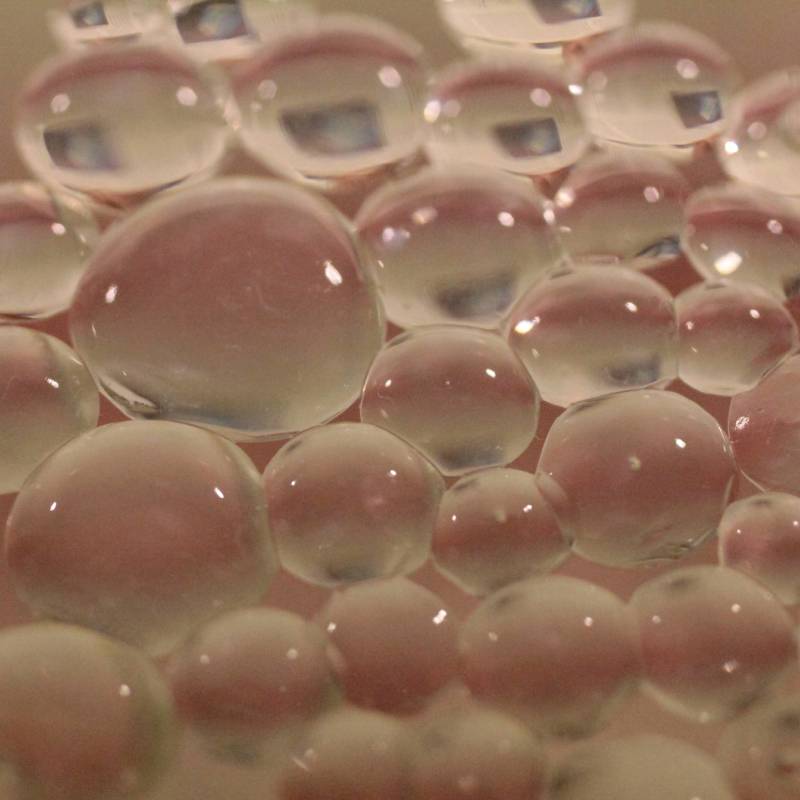看到藝術:【微分影像:徐嘒壎影像作品中的構成與虛擬】 Image of differentiation – the constitution and virtuality in Hui-Hsuan Hsu’ moving image
2017-06-09|撰文者:黃瀞瑩/看到藝術
閱讀徐嘒壎的影像作品,很難迴避其所設定的時間尺幅。在仿若無人執掌、一鏡到底的微距鏡頭下,被攝錄之物,以一種陌異且曖昧的運動狀態在影像中呈現微小但確實的變化,此種細微的動態綿延甚至可達到一般敘事電影的時間規模(以作品《米》為例,總長為1小時26分26秒)。過量的時長,卻僅提供微量、幾近難以感知的影格速度,是徐嘒壎作品最主要的裝置要素。對觀者來說,這無疑是一項挑戰。
When reading Hui-Hsuan Hsu’s image works, beholders are hard to avoid the time scale set in. Under long take by micro lens, as if no one conducting, shot objects present micro but solid variations in foreign and ambiguous movements in images; these nuances of dynamic duration can even last for the large time scale as general narrative cinema (for example, the length of the work Rice is an hour, 26 minutes and 26 seconds). The extremely long duration only provides minimum and imperceptible frame pace, which is the most essential component of Hui-Hsuan Hsu’s works. For her works’ viewers, it is no doubt a challenge.
關於速度的調控,一直是當代影像生產的基本語法。相較於一般敘事影像的配速模式,透過動靜快慢製造出戲劇化的閱聽焦點,類比或反差主體的內在情狀,徐嘒壎在2012年後的影像作品中所呈現的時長,並不能輕易化約為心理時間上的「緩慢」或主觀狀態的「凝視」,毋寧說,它更像是藉此進行影像構句的文法分析,藉由低度且少量的數位後製,直指影像可能的虛擬威力。其創作圍繞著影像的先決條件而展開,諸如:框,鏡頭與圖層,以及攝影/放映的光學儀器,並折返在如詩的影像結晶中。
The pace control is always a basic syntax of contemporary image production. Compared to the pace mode in general narrative images which create dramatic reading climaxes, analogy or contrast to subjects’ inner sentiments, Hsu’s works after 2012 cannot easily be reduced to “slowness” in mental time or “gaze” in subjective state. Rather, she analyzed the image syntax by her works. Using low and few digital post-production, her works direct to the potential virtual power. Her works set out with some image preconditions—such as frames, lens, layers, and shooting/projecting optical instruments—and refracted in poem-like image crystals.
框 Frame
不論是在數位軟體(Final Cut Pro)介面中設定個別的時間軸製造出「影像的拼貼」,或是著重在鏡頭本身的邊框對於視野的裁切、讓所在抽象化,景框、物框與數位框線及其間的交互構成,是徐嘒壎在2012-2013年間最主要的創作路徑。作品《居所(Settlement)?》預先剪裁、框取了個別錄製的影像,順沿著被攝物本身的邊界(水面、門板、毛毯)將局部化的物像縫合為帶有平衡感或對位性的構圖。由於焦距的巨幅調動與微距鏡頭下呈顯的物質動態,這些被並置的影像在差異的流速中產生一種近乎「視觸性」的激烈震盪。《盲看(blind)-1》建立在景框(frame)與物框(百葉窗的格柵)所構成的複數框格之上,轉動百葉窗產生的光影閃爍,讓「物體自身的框線」與「分割影像的數位框線」產生奇異的混淆。作品中的「數位框線」有時沉入影像中轉折出知覺與想像的深度,有時又被其各自連接的影像所拉扯侵佔,影像皺褶為特異的「非平面」。在仿若羅斯科(Mark Rothko)作品的構圖與色調中,《盲看(blind)-2》則是在景框中調動著物體本身。伴隨著物體運動不斷生成的水平軸線,模糊了景深與空間的等比關係;鏡頭聚焦處清晰顯現的物質肌理,引誘著想像為畫面給定某種深度,而這些在視野中暫時成形的空間,卻在影像中一再翻覆。
The main approaches of Hsu’s works in 2012-2013 are: creating respective “image collage” of individual period in the software interface of Final Cut Pro; emphasizing the frame of lens and cutting the scopes to abstract the places, and inter-composing the landscape, object and digital frames. The work Settlement cut and framed recording images beforehand, and sew along the shot objects (water surface, door board, blankets), rendering object parts into balanced or para-position composition. Owing to the special material motion created by largely modulating focal lengths and macro lens, these juxtaposed images generate a nearly “haptique” oscillation in differentiated speed flow. The work Blind-1 builds on frames of landscapes and objects (the grid of shutters) which compose plural grids. The revolving shutters create glittering lights and shadows, peculiarly mixing up the “outlines of objects’ selves” or “digital outlines of divided images”. The “digital outlines” in works sometimes immerse into images, turn out the depths of awareness and imaginations, but sometimes are occupied by their joint images. The folding of images are singular “non-plan”. Similar to the compositions and tonalities in Mark Rothko’s works, the work Blind-2 modulates objects’ selves in frames. The horizontal axes, which are continuously generated from object’s movements, blurs the depth of field and the geometric ratio relationship of spaces. The material texture vividly represented under lens’ convergence, eliciting imaginations to give pictures a certain depth, but the temporarily-made space were overridden repeatedly in image.
鏡頭與圖層Lens and Layers
《米(rice)》採用逐格播放攝影影像的作法,透過數位軟體中淡入重疊的設定,製造出綿延的情狀。由於靜態影像原初的光源設定,等距前進或後退的米粒列陣沉浸在光的虛擬運動中,呈現出個別殊異的色澤與質量的漸次變化。同步並進的內外設定(米粒的列進與鏡頭的調校),反向指涉攝影機具的內在維度,透過焦距、光圈、快門與感光元件等要素,以微縮的比例投影出相機內部已預先存有的潛在視域,鏡頭視野的先驗條件。《蘋果(apple)》重疊了兩張近乎相同的靜態攝影,差別只在於上層圖層的蘋果因剛自冰箱取出而帶有霧霜,藉由數位軟體中的橡皮擦功能,上層圖層的挖空處顯現出下層圖層,霜與臘在蘋果表面形成溶解與流動的「時態變化」。《杯與盤(Cup and Saucer)》則是實地操演了數位語法中的圖層設定,藝術家在iPad上播放預先錄製的茶盤,爾後將真實的杯子放置在微微晃動的茶盤影層上方再行攝錄。作品中的杯與盤形現出詭異的震顫,此種震顫彷若來自於「影像與影像」的夾層,一個虛擬的暗黑地帶。
The work Rice uses stop-motion techniques which sets fade-in overlapping effect in digital software, creating the state of duration. Owing to light setting of original still pictures, the rice array moving forward or backward in equidistance is immersed in virtual movement of light, rendering distinctive individual color and gradient variation of quality. Sync-operated inner and outer setting (the rice array and lens modulations) reversely refers to the inner dimension of camera. Through focal lengths, aperture, shutter, and image sensors, the work projects the original existed potential vision of camera, the transcendental conditions, in macro proportion. The work Apple overlaps two nearly identical still photographs—the only difference is that the apple on upper layer is just taken from refrigerator and has a frost coat on surface. Utilizing the eraser function in digital software, the hollow area of upper layer reveals the under layer, and the frost and wax forms the melting and flowing “chronological variation”. The work Cup and Saucer truly operate the layer setting of digital syntax. The artist broadcasted pre-recording saucer on iPad, and put the real cup on slightly shaking saucer layer, and then recorded again. In this work, the cup and saucer display wired oscillation, this kind of oscillation as if comes from the layer in-between “image and image”, a virtual black zone.
光學儀器Optical Instruments
藝術家近期的「折射體」系列(《空司》、《睡眠曲》、《麗知》),則是透過水滴、洋菜或果凍等半透明介質,呈現出「製造影像」與「影像自身」的交纏狀態。同樣是透過攝影的逐格撥放,在《閱讀皮皮洛蒂.瑞斯特(Reading Pipilotti Rist)》中,大大小小的洋菜珠吸納了皮皮洛蒂.瑞斯特(Pipilotti Rist)攝影作品的光彩,同時即刻互動映射出差異的多重倒影。複數的洋菜珠群構成了微型的「鏡頭/螢幕」,同步「攝錄/放映」影像,讓我們想起納吉(Laszlo Moholy-Nagy)在上個世紀初有關球體螢幕及其投影的假設與想像。透過此種手工等級的光學儀器,「折射體系列」在影像趨向純粹視覺存有的數位時代中,反身召喚著一種觸覺性的影像存有情狀。
The artist’s recent series Reflection Bodies (Cones, Lullaby, Litchi ) used translucent drops, agar beads, or jelly to represent the intertwining status of “image making” and “image itself”. Similarly played by stop-motion, in Reading Pipilotti Rist, different sizes of agar beads absorb the luster of Pipilotti Rist’s photographs, inter-reflect different inverted images simultaneously. Plural clusters of agar beads compose the macro “lens/screen”, sync-“recording/broadcasting” image, recalling us to Laszlo Moholy-Nagy’s hypothesis and imagination of sphere screen and projection in the beginning of the last century. By utilizing this kind of handmade optical instrument, “Reflection Bodies” series reflexively invokes a kind of tactile sense in image’s existence status in the digital age in which images tend to exist in pure visuality.
不同於當代影像技術在每秒可攝映之最大格數值上的「擬真」式追求,徐嘒壎的動態影像系列,往往透過巨幅的時間配置(每張影格所佔據的時間皆長達數秒),讓攝影的「此曾在」,在影像中抽象化為一種特異的虛構運動。米粒、冷藏蘋果、水滴,肥皂、百葉窗、英式下午茶杯,這些在漫漫歲月中重複出現的日常物件,成為徐開啟影像之異質潛能的入口。其影像作品猶如一道具有微分意義的函數,透過這些在影像構成之先決條件上的操作,描繪吾人之感知與想像的動態臨界,指認出潛藏於當代視覺經驗內部的虛擬維度,及其可能伴隨的差異化運動。
Different from contemporary image techniques in pursuing “simulated reality” by maximizing the frames per second, Hsu’s motion image series usually manages the extremely large time scale (every frame occupies several seconds) to abstract the “that-has-been” of photography rendering into a kind of singular virtual movement in image. Rice, chilled apples, drops, soap, shutters, tea cups, these daily objects which repeatedly turn up through years, become the entrance that Hsu enter to explore the singular potential of images. Her images are like a function with differential meaning. By operating the preconditions of image constitution, these works illustrate one’s perception and imagination on dynamic edges, pointing out the lurking virtual dimensions within contemporary visual experience and their accompanied differentiated movements.



